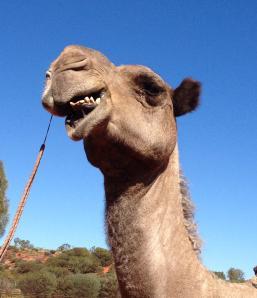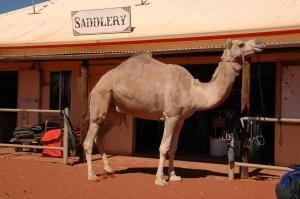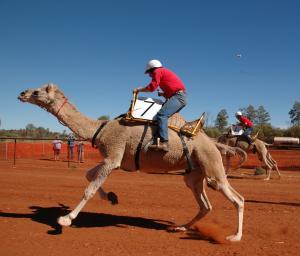
Camels were used as transport to colonize outback Australia
How about this for getting away from it all – join a camel trek from Alice Springs to Port Augusta – and raise money for drought relief by tagging along.
I’ve recently come back from the Uluru Outback Fest, in Australia’s Northern Territory. It’s a fabulous weekend combining dining experiences in the desert, interpretive tours of Uluru, or Ayers Rock, and the main event, camel racing, which is where I heard about Camels for Drought Relief.
The Camel Cup is held at Uluru Camel Farm and on race day there are stalls set up around the racetrack. It was at one of these stalls I met the lovely Hannah Purss. Between racing camels she was taking donations for drought relief and selling jewelry she’d made to help fund the project Camels for Drought Relief.
Shocked at the plight of farmers suffering from the worst drought in Australian history, Hannah, together with her boyfriend Evan Casey, decided to do something about it.

Hannah and Evan at the Uluru Camel Cup
Hannah, originally from Sydney, and Evan, from South Australia, have been working with camels in the Australian outback for a number of years, training, riding and racing them, so the idea to use camels to raise awareness of drought-plagued farmers seemed like a good idea (at the time).
Camels were introduced into Australia in the 1800s for transport during colonization because of their ability to withstand the harsh outback conditions. With the advent of motorised transportation, camels were no longer needed and released into the wild. It’s estimated the feral population grew to one million before culling was introduced to prevent them from degrading the environment and threatening native species.

Most of Australia’s camels are dromedaries (one-humped camels)
As camels were used to help build the outback, Hannah and Evan decided to use them to help rebuild it, via funds raised from a camel trek. On reflection, Hannah says they probably didn’t think it through too much, but they have persevered.
They caught three wild camels at Mulga Park Station in late 2013 and have been training them ever since. Hannah describes Timmy, Crixus and Hugo as “enormous hairy beasts with big hearts to match”.
Hannah and Evan are funding the trek themselves and in order to save money have moved into a tent. They’ve been building the wagon they’ll use from recycled materials, mostly found at the Uluru dump. Evan is currently making some last-minute improvements before the trek commences on July 13 from the Lasseters Camel Cup in Alice Springs.

A camel in full flight at the Uluru camel Cup
They’ll be on the road for more than three months, and you can join them for part of the trek between Alice Springs and Finke. (They are offering transport from Uluru or Alice Springs to their location.)
It’s an awesome way to see the outback – sleeping under the stars, eating around a campfire, traveling in an eco-friendly way and in great company. And you’ll be helping raise money for our farmers. You can even get your friends to sponsor you to help raise further funds.
If you can’t make the trek, you can still donate to Camels for Drought Relief through their link at Everyday Hero. If you’d like to help fund their trip (they still need to buy medical supplies, camp supplies etc) you can do so through Go Fund Me.
It’s a fantastic initiative by two young Australians to give back to the country and I applaud them for their effort and hard work. Well done Hannah and Evan and good luck!
For more details visit Camels for Drought Relief or follow them on Facebook, Twitter and Instagram.
More: Voyages Ayers Rock Resort
You can read about my time at the Outback Fest in an up-coming article in Escape travel.

